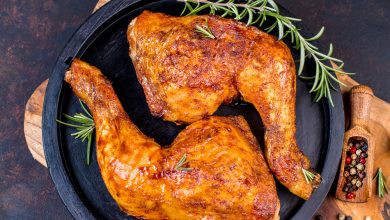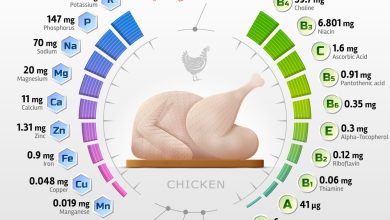From Calories to Protein: Decoding Chicken Breast Nutrition Facts

Understanding nutrition is a cornerstone of maintaining a healthy lifestyle. With a myriad of food choices available, making informed decisions about what we eat can significantly impact our overall well-being. Chicken breast, in particular, stands out as a popular dietary choice for many individuals striving for a balanced and nutritious diet.
Its versatility in recipes, along with its impressive nutritional profile, makes it a staple in kitchens around the world. Whether you’re aiming to build muscle, lose weight, or simply eat healthier, delving into the nutrition facts of chicken breast can provide you with valuable insights on how it can support your dietary goals.
Section 1: Caloric Content
Calories serve as the energy currency of our body, fuelling every function from basic metabolic processes to intense physical activity. Understanding the caloric content of the foods we eat is crucial for managing energy intake and maintaining a healthy weight. A 3.5-ounce (100-gram) serving of cooked, skinless chicken breast contains approximately 165 calories, making it a lean and efficient protein source for those mindful of their caloric intake.
To put this in perspective, the same serving size of salmon has about 206 calories, while a portion of lean beef tops the scale at around 250 calories. This makes chicken breast not only a lower-calorie alternative but also a versatile option that can seamlessly fit into various dietary plans, from muscle building to weight loss. By incorporating chicken breast into your meals, you can enjoy a satisfying, nutrient-dense food that supports sustained energy levels without an excessive calorie burden.
Section 2: Protein Powerhouse
Protein is a vital macronutrient essential for the growth, repair, and maintenance of tissues in our body. It plays a crucial role in producing enzymes and hormones, supporting immune function, and serving as a critical building block of bones, muscles, cartilage, and skin. Chicken breast shines as an exemplary source of protein, delivering about 31 grams of this essential nutrient per 3.5-ounce (100-gram) serving.
This high protein content not only helps in muscle repair and growth, especially for athletes and bodybuilders, but also promotes satiety, aiding in weight management by keeping you fuller for longer periods.
To amplify your protein intake using chicken breast, consider incorporating it into a variety of meals such as salads, stir-fries, or simply grilling it with your favorite spices and herbs. Additionally, marinating chicken breast before cooking can add flavor while maintaining nutritional quality, making it an enjoyable and effective way to meet your protein needs.
Section 3: Essential Vitamins and Minerals
Chicken breast is not only renowned for its protein content, but it also boasts an impressive array of essential vitamins and minerals that contribute to overall health. Key nutrients found in chicken breast include B vitamins such as niacin (B3), which supports energy production and brain function, and pyridoxine (B6), crucial for amino acid metabolism and the synthesis of neurotransmitters.
Additionally, chicken breast contains significant amounts of phosphorus, which is vital for maintaining healthy bones and teeth, and selenium, a powerful antioxidant that plays a role in immune function and thyroid health. Incorporating chicken breast into your diet can help ensure you receive these essential nutrients, supporting various bodily functions from maintaining energy levels to protecting against oxidative stress.
To balance your vitamin and mineral intake effectively, consider pairing chicken breast with a variety of vegetables and whole grains, which can provide complementary nutrients and enhance the overall nutritional profile of your meals.
Section 4: Fat Content and Its Significance
Understanding the fat content in chicken breast is essential for making informed dietary choices. Chicken breast is predominantly low in fat, containing about 3.6 grams of fat per 3.5-ounce (100-gram) serving, with a low proportion of saturated fats.
The majority of the fat found in chicken breast is unsaturated, which is considered heart-healthy and beneficial for maintaining cholesterol levels. This makes it an excellent choice for those looking to minimize their intake of unhealthy fats without sacrificing important nutrients. When compared to other protein sources, such as red meat, which can contain higher levels of saturated fats, chicken breast stands out as a leaner alternative that supports cardiovascular health.
Moreover, the low-fat content in chicken breast aligns well with various dietary plans, including those aimed at weight loss and muscle building, as it allows for versatile preparation methods while keeping overall fat intake in check. Integrating chicken breast into your diet can, therefore, help you manage fat consumption more effectively and support long-term health goals.
Section 5: Cooking Methods and Their Impact on Nutrition
The method you choose to cook chicken breast can significantly affect its nutritional value, making it essential to opt for techniques that preserve its health benefits. Grilling and baking are among the healthiest ways to prepare chicken breast, as they typically require minimal added fats and help retain essential nutrients. Grilling, in particular, allows excess fat to drip away from the meat, reducing overall fat content.
On the other hand, frying adds unnecessary calories and saturated fats, diminishing the health benefits of this lean protein. To maintain the nutritional integrity of chicken breast while cooking, consider using methods such as steaming or poaching, which preserve moisture and nutrients without the need for added oils.
Additionally, marinating chicken breast in a mixture of herbs, spices, and a small amount of healthy fats like olive oil can enhance flavor without compromising its nutritional profile. By choosing these cooking techniques, you can enjoy the full nutritional benefits of chicken breast while keeping your meals both delicious and health-conscious.
Conclusion
In conclusion, chicken breast stands out as a stellar choice for anyone focused on nutrition and mindful eating. We’ve explored its role as a low-calorie, high-protein food that can markedly contribute to muscle repair and growth while aiding in weight management. Its rich content of essential vitamins and minerals, like niacin, pyridoxine, phosphorus, and selenium, further amplifies its value in a balanced diet. Additionally, the low-fat nature of chicken breast, particularly its heart-healthy unsaturated fats, makes it an excellent substitute for higher-fat proteins, supporting cardiovascular health.
By incorporating chicken breast into a variety of meals—whether in salads, stir-fries, or grilled dishes—you can ensure you’re meeting your nutritional needs without compromising on taste or adding unnecessary calories. Opting for healthy cooking methods such as grilling, baking, or steaming ensures that you preserve the nutritional benefits while exploring a range of delicious flavors.
As you journey through your nutritional goals, remember that mindful eating plays a crucial role in achieving long-term health. Being conscious of the quality and preparation of the foods you consume can make a significant difference in your overall well-being. Embrace chicken breast as a versatile, nutrient-dense component of your diet, and continue to prioritize balanced eating to support a healthier, more vibrant you.




